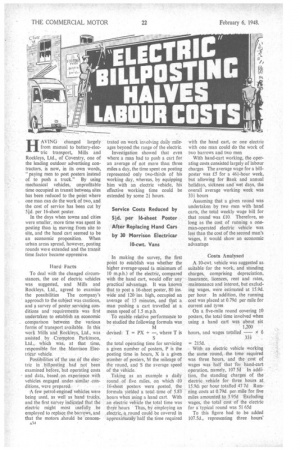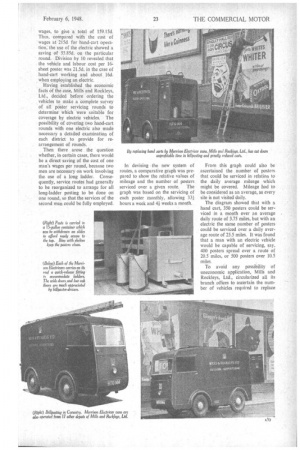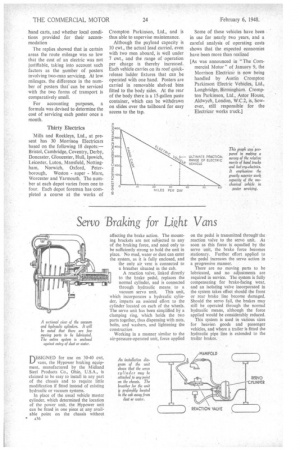Service Costs Reduced by Sid. per 16-sheet Poster After Replacing Hand Cars by 30 Morrison Electricar 10-cwt. Vans
Page 48

Page 49

Page 50

If you've noticed an error in this article please click here to report it so we can fix it.
HA VING changed largely from manual to battery-electric transport, Mills and Rockleys, Ltd., of Coventry, one of the leading outdoor advertising contractors, is now, in its own words, "paying men to post posters instead of to push a truck." By using mechanical vehicles, unprofitable time occupied in transit between sites has been reduced to the point where one man can do the work of two, and the cost of service has been cut by 51d. per 16-sheet poster.
In the days when towns and cities were smaller, more time was spent in posting than in moving from site to site, and the hand cart seemed to be an economic proposition. When urban areas spread, however, posting rounds were extended and the transit time factor became oppressive.
[lard Facts To deal with the changed circumstances, the use of electric vehicles was suggested, and Mills and Rockleys, Ltd., agreed to examine the possibilities The company's approach to the subject was cautious, and a survey of poster servicing conditions and requiremerits was first undertaken to establish an economic comparison between the various forms of transport available. In this work Mills and Rockleys, Ltd., was assisted by .Crompton Parkinson, Ltd., which was, at that time, responsible for .the Morrison Elec tricar vehicle. • Posgibilities of the use of the electric in . billposting had not been examined before, but operating costs and data, based on experience with vehicles engaged under similar con ditions, were prepared. • •
• A few petrol-engined vehicles were being used, as well as hand trucks, and the first survey indicated that the electric might most usefully be employed to replace the barrows, and that the motors .should be concea
trated on work involving daily• mileages beyond the range of the electric.
Investigation showed that even where a man had to push a cart for an average of not more than three miles a day, the time spent on posting represented only two-thirds of his working day, whereas, by equipping him with an electric vehicle, his effective working time could be extended by some 21 hours.
In making the survey, the first point to establish was whether the higher average-speed fa minimum of 10 m.p.h.) of the electric, compared with the hand cart, would offer any practical advantage. It was known' that to post a 16-sheet poster, 80 ins. wide and 120 ins, high, occupied an average of 15 minutes, and that a man pushing a cart travelled at a mean speed of 1.5 m.p.h.
To enable relative performance to be studied the following formula was devised: T = PX —, where T is the total operating time for servicing a given number of posters, P is the posting time in hours, X is a given number of posters, M the mileage of the round, and S the average speed of the vehicle.
Taking as an example a daily round of five miles, on which -10 16-sheet posters were posted. the formula yielded a total.time of 5.83 hours when using a hand cart With an electric vehicle the total time was three hours Thus, by employing an electric, ,a _round could be covered in approximately half the time required
with the hand cart, or one electric with one man could do the work of two barrows and two men With hand-cart working, the operating costs consisted largely of labour charges The average wage for a billposter was £5 for a 461-hour week, but allowing for Bank and annual holidays, sickness and wet days, the overall average working week was 331 hours Assuming that a given round was undertaken by two men with hand carts, the total weekly wage bill for that round was £10 Therefore, so long as the cost of running a oneman-operated electric vehicle was less than the cost of the second man's wages, it would show an economic advantage Costs Analysed A 10-cwt. vehicle was suggested as suitable for the work, and standing charges, comprising depreciation, insurance, licences, rent and rates, maintenance and interest, but excluding wages, were estimated at 15.9d. per hour In addition, the running cost was placed at 0.79d per mile for current and tyres On a five-mile round covering 10 posters, the total time involved when using a hand cart was about six 1,200
hours, and wages totalled — x 6 33-1 , = 2I5d. .
With an electric vehicle working the same round, the time required was three hours, and the cost of wages was half that foi hand-cart operation, namely, 107 5d In addition, the standing' charges of the electric vehicle for three hours at 15.9d. per hour totalled 47 Id Running costs at 0.79d per Mile for five miles amounted to 3 95d Excluding wages, the total cost of the electric for a typical round was 51 65d To this figure had to be added 107.5d., representing three hours'
wages,. to give a total of 159.15d. Thus, compared with the cost of wages at 215d. for hand-cart operation; the use of the electric showed a saving of 55.85d. on the particular round. Division by 10 revealed that the vehicle and, labour cost per 16= sheet poster was 21.5d. in the case 'of hand-cart working and about 16d. when employing an electric.
Having established the economic facts of the case, Mills and Rockleys, Ltd., decided before ordering the vehicles to make a complete survey of, all poster servicing 'rounds to determinewhich were suitable for coverage by electric vehicles. The possibility of covering two hand-cart rounds with one electric also made necessary a detailed examination of each district to provide for rearrangement of rounds.
. Then there arose . the question whether, in certain cases, there would be a direct saving of the cost of one man's wages per round, because two men are necessary on work involving the. use of a long ladder. Consequently, service. routes had generally to be reorganized to arrange for all long-ladder posting to be done on one round, so that the services of the second rn6n could be fully employed.
In devising . the new system of routes, a comparative graph was prepared to show the relative values of mileage and the number of posters serviced over a given route. The graph was based on the servicing of each poster monthly, allowing 33i hours a week and 4i weeks a month.
From this graph could also be ascertained the number of posters that could be serviced in relation to the daily average mileage which might be covered. Mileage had to be considered as an average, as every site is not visited daily.
The diagram showed that with a hand cart, 350 posters could be serviced in a month over an average daily route of 3.75 miles, but with an electric the same number of posters could be serviced over a daily average route of 25.5 miles. It was found that a man with an electric vehicle would be capable of servicing, say, 400 posters spread over a route of 20.5 miles, or 500 posters over 10.5 miles.
To avoid any possibility of uneconomic application, Mills and Rockleys, Ltd., circularized all its branch .offices to ascertain the number of vehicles required to replace hand carts, and whether local conditions provided for their accommodation The replies showed that in certain areas the route mileage was so low that the cost of an electric was not justifiable, taking into account such factors as the number of posters involving two-man servicing. At low mileages, the difference in the number of posters that' can be serviced with the two forms of transport is comparatively small.
For accounting purposes, a formula was devised to determine the cost of servicing each poster once a month.
Thirty Eleetrics
Mills and Rockleys, Ltd., at present has 30 Morrison Electricars based on the following 18 depots:— Bristol, Cambridge, Coventry, Derby, Doncaster, Gloucester, Hull, Ipswich, Leicester, Luton, Mansfield, Nottingham, Norwich, Oxford, Peterborough, Weston super Mare, Worcester and Yarmouth. The number at each depot varies from one to four. Each depot foreman has completed a course at the works of Crompton Parkinson, Ltd., and is thus able to supervise maintenance.
Although the payload capacity is 10 cwt., the actual load carried, even with two men aboard, is well under 7 cwt., and the range of operation per charge is thereby increased. Each vehicle carries on its roof quickrelease ladder fixtures that can be operated with one hand, Posters are carried in removable shehed bins fitted to the body sides. At the rear of the body there is a 15-gallon paste container, which can be withdrawn on slides over the tailboard for easy access to the tap.
Some of these vehicles have been in use for nearly two years, and a careful analysis of operating costs shows that the expected economies have been more than realized
[As was announced in "The Commercial Motor" of January 9, the Morrison Electricar is now being handled by Austin Crompton Parkinson •Electric Vehicles, Ltd., Longbridge, Birmingham. Crompton Parkinson, Ltd., Astor House, Aldwych, London, W.C.2, is, however, still responsible for the Electricar works truck.]
















































































